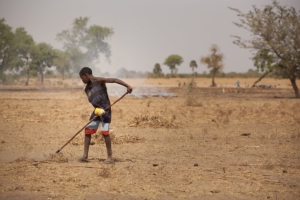The Effects of Desertification in Africa
 Desertification is a process that destroys fertile land. This can be caused by drought, overpopulation, over-farming, deforestation and climate change. The effects of desertification are seen in many parts of the world, but is predominantly in India, Australia, Asia and Africa. More than six million acres of land in India are turned into a desert-like state annually. The U.N. estimates about 30 million acres of land across the globe are impacted by desertification every year.
Desertification is a process that destroys fertile land. This can be caused by drought, overpopulation, over-farming, deforestation and climate change. The effects of desertification are seen in many parts of the world, but is predominantly in India, Australia, Asia and Africa. More than six million acres of land in India are turned into a desert-like state annually. The U.N. estimates about 30 million acres of land across the globe are impacted by desertification every year.
The most vulnerable region is a 3,000-mile stretch of land that includes ten countries in the Sahel region of Africa. The Sahel is the area between the Saharan Desert and the Sudanian Savannah. This region is under constant stress due to frequent droughts and soil erosion. A dense forest can become a field of dust in a matter of years, making mass migrations inevitable. Africans frequently migrate south in search of fertile land.
Desertification in Senegal and Beyond
Desertification affects about 46 percent of Africa. Yet, the process of reversing its effects is slow going, usually taking a decade to see major improvements. Agriculture in Africa tends to result in low productivity, as most of the land is characterized as a semi-desert. Clearing the land of trees also reduces the structure of the soil. Coupled with wind erosion, the topsoil blows away and leaves a desert-like land. The issue is seen in many parts of the world, but it is most prevalent in Africa.
The country that is arguably the most damaged by desertification is Senegal. Migrations in Senegal are common, as wind erosion, deforestation and climate change wreaks havoc on farms and livestock. In 2015, Khalidou Badara, a cattle herder in Senegal, said, “There are almost no more trees, and the grass does not grow anymore, and so each year, we have to go further and further away to find grazing for our cattle.” Those most affected by desertification in Senegal move to Gabon, a country in West Africa, or even to Europe or South America. More than half of Senegalese work in agriculture, and desertification forces those with meager profits to move elsewhere to escape poverty.
The Great Green Wall
One ambitious initiative created to reduce desertification in Africa is the Great Green Wall. Once completed, the Great Green Wall will be the largest living structure on the planet, spanning more than 4,500 miles across the entire Sahel. The idea is that planting trees can combat desertification, create jobs, improve food security and bring migrated populations back home. The initiative began in 2007 and has already planted 12 million trees in Senegal. The wall prevents the Saharan Desert from encroaching on land most affected by desertification in Africa, while simultaneously reducing soil erosion. More than 37 million acres of degraded land in Ethiopia was restored as a result of this initiative.
There are similar results in Burkina Faso, Nigeria and Niger. Only 15 percent of the project is complete, and the Great Green Wall is creating a lasting impact. The Great Green Wall’s goals for 2030 include restoring 247 million acres of destroyed land and creating 10 million jobs in rural areas.
Will Desertification Halt or Slow?
As climate change continues to place a burden on poor farmers in the Sahel region, scientists and initiatives, like the Great Green Wall, continue to restore the region to its original structure. The Great Green Wall is growing every month. Its ambitious goals for 2030 express that their work will not slow in Africa. The greatest impact of these solutions lies in preventing further desertification in Africa so that those in poverty can depend on fertile land for food and sufficient income to escape poverty.
– Lucas Schmidt
Photo: Flickr
